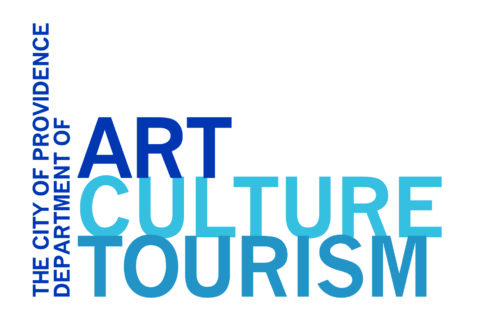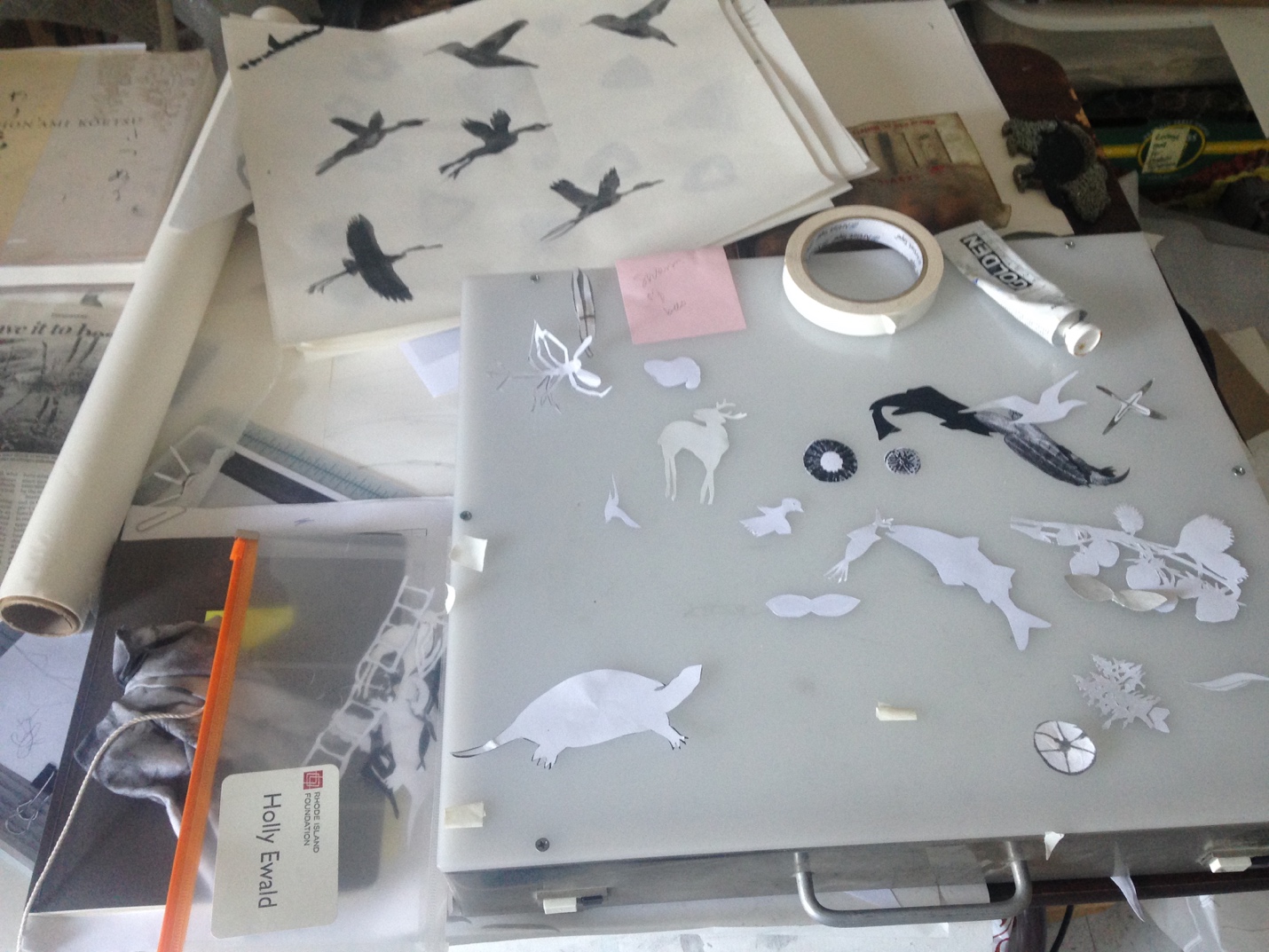An Artist At Work
by HOLLY EWALD, PROVIDENCE ARTIST | APRIL 12TH, 2017
Through journal entries that archive her time in the studio, Holly Ewald shares intimate details of how she designed the Full Circle: Art as Reflection floating film screen, exhibited last year on Mashapaug Pond. Holly is well known for her innovative work as an environmentalist and teaching artist at UPP Arts, yet it is here in her excerpts from her journal where she shares with us the most essential component of what it is to be an artist: time in the studio. Holly’s uncensored and fearless writings shed light on the ways that a fan in a child’s room, plankton, the open weave of burlap, serendipitous visits from other artists, and being on the pond, move her from inspiration to production.
June – September, 2015:
Concept of the buoyant sculpture solidified by Holly Ewald and the Steel Yard: A vertical half circle filled with decorative metal silhouettes of natural life found currently and/or historically around the pond; everything from plankton to birds all structurally supported by a fan-like arrangement of metal pipe.
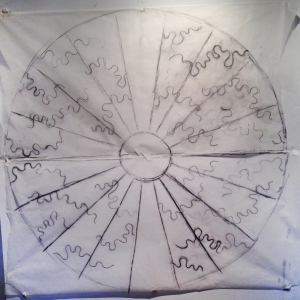
June 27, 2015 (Home studio)
Three 4’-wide newsprint half circles on the wall with complimentary half circles mirrored. I’m working in ink on top of gessoed burlap to get a modeled effect, a ground or landscape or background on which to do the linear design for the interior of the semi-circle. I’m laying down ground in big swaths of ink of various densities using free and playful gestures. This allows me to act and watch the response, then respond and watch … It reminds me of doing multiple takes on a single mono print, but here I am painting through burlap – open weave sculptor’s burlap – lifting the burlap to see, painting, lifting the burlap to see … There are no images just shades of light and dark and texture. I’m playing and procrastinating because I still don’t know what the imagery will be in the semi-circle.
July 18, 2015
I’m in Los Angeles visiting my son who is doing an internship at Space X. I’m staying at Elia and Erik’s Gurna’s home. Raffe and Rosie, Elia and Eric, what a wonderful alive and generous family! I love that Elia’s spirit is here even though she is not. Eric is kind and warm and giving. The ceiling fan in Rosie’s room where I sleep clicks away. Rosie’s drawings lift, curve and lay back against the wall randomly.
July 20, 2015 (Elia’s studio in LA)
Got to spend a little time in Elia’s studio working on new design idea for Full Circle. I am inspired by Rosie’s blue fan on her dresser. It makes sense, could be good, moving from plankton to birds in 6 sections with middle section vertical water wave lines. It incorporates the plankton at the bottom, (with reflection, the largest section) and moving on to fish, animals, plants, insects, birds. Water to air. It is almost lace-like, which I like. It will appear as a circle/disc on the pond. As it is pulled to shore for film nights people will see the imagery. Thinking of the plankton shapes being the basic shapes to develop the other imagery, like the plankton being the basic foundation of the food chain.

August 17, 2015 (Home Studio)
Finally beginning to draw. Got the shape to size for the 16’-wide half circle drawn on my white linoleum floor. Looking at plankton, basic shapes, reminding me of children’s early drawings. Looking at Rhoda Kelloggs’s book, Analyzing Children’s Art. As I thumb through I see motifs from different cultures. Such similar shapes to the plankton: triangles, circles, spoked circles, rectangles linked, Chinese motifs remind me of Landscape/Landscript by Xu Bing.
August 20, 2015 (Home studio)
I keep figuring out what I don’t want to do. How wide do I make the fan sections delicate like a scallop shell or leave them open with space? I go back to cut out shapes I created as I played with a round bamboo brush. I need to play with shapes for plankton, animals and insects. I want to show design idea to Diane (longtime resident near Mashapaug Pond) and Loren (Director of the Tomaquag Museum).
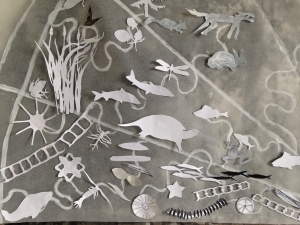
August 23, 2015 (Home studio)
Looking at Shahzia Sikander ‘s work. I love the mix of layered imagery. I think of the possibility of mixing my sections more. I need to paint with ink. Drawing with charcoal on tracing paper is not working as well as in the past. I have to shake loose of it. The most important thing is to keep drawing/painting and playing within the semi-circle, with plankton at the base. Playing with ink and brushwork on different papers; newsprint, rice paper and vellum.
September – December, 2015:
I wanted the imagery within the sculpture to be accessible to the general public and to represent the natural life around the pond today and from the past. There are many animals, birds and fish that are no longer present with the steady growth of the human population and the constant elimination of various species; however, current residents have mentioned seeing red fox, rabbits, coyotes, cormorants, raccoons, snapping turtles, tit mice, starlings, wide mouth bass, yellow perch, sunfish and more. It was important to me that a significant reference be made to the area’s Indigenous Culture, to the first humans to inhabit this land and built their homes around the pond, made vessels out of clay from its embankments and fished from its waters. The half circle shape of Full Circle: Art as Reflection echos the weetu, the dome-like form which Indigenous people built for their summer homes. The inner half circle of Full Circle represents the weetu structure with its domed gridded form. Cattails grew along the shore line and had many uses for Indigenous people including mat making, roots for food and the fuzzy tops for absorption in diapers. Today cattails can be used for helping to filter the toxins in the pond. I imagined the arrangement of images growing from water, inhabitants in the bottom sections of the bands of the fan parallel to the water and to those of the land and sky as the half circle came to the center and the fan sections became more vertical.
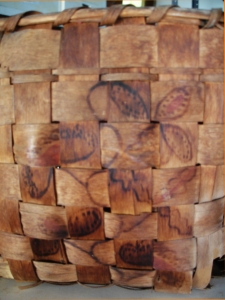
September 2, 2015 (Home studio)
Jessica came by yesterday. She helped give me a shove to loosen up, not be so literal, get more of my hand in the work. I’ve been stymied about how to get an overall decorative structure beyond the fan ribs. She helped me think across the fan segments which I had been contemplating but needed a push. We looked at the photo of iron grill work I had taken in LA. She showed me what she learned working on decorative rugs, connecting the figures with a line. The curved linear work in the wrought iron grill work was more European. I showed her my research on designs on the ash splint baskets made by Indigenous people in New England. There are various trail designs that might symbolize paths. I chose a simple version of them to repeat throughout the half circle, at first staying with the sections, then moving across borders. I laid a clear tracing paper over an earlier half circle that was meant to be a background of sorts.- the light and dark of the site on the pond. I’m working in white on this paper and its helping me see the piece. Not sure about the scale of figures. I need to do more to fill it up. Working again with painting more images w/black ink to get to play with brush and ink – a medium I’m been fearful of using for so long. Now it is the only media I want to use – so many possibilities. I like how I have to observe the ways water makes the ink do different things depending on the amount of water, timing of application, proximity of subsequent strokes near wet, damp ink… Working/playing with the natural language of the media.
The experiments I did in preparation for doing marbleized prints for the UPP Arts public workshops last spring is helpful in terms of understanding and enjoying working with water and ink. I worked in the morning getting more figures in the half circle. One area is beginning to work, the lower left. The turtle is larger, the story teller according to Narragansett teaching. Getting back into painting the figures – placement of brush, angle and turn of the wrist – beginning to remember from experiments earlier. It feels right; it feels good.
It is interesting, the power of the silhouette. The cruder figures mixed with the more delicate, more detailed ones. I like it, but wonder if it is ok. What is it saying? – Cruder, more wild, more gut, instinctive, emotional? Can plants be crude, not in themselves but what does it say when they are rendered more crudely? I may try doing some white figures on tracing paper and over lay them on the half circle I am working on.
October 25, 2015 (Home studio)
Decidedly want to leave the middle section open. Made a new background for another design overlay. this time on vellum. Worked it similarly to the one on newsprint with the burlap. Ink of various proportions with water. Painted, scrubbed, spattered through the burlap and plastic netting. Some in-painting with ink on top. Got a nice feel of woods landscape.
November 22, 2015 (Home studio)
Haven’t been in studio much, working more on UPP Arts. Meetings with residents about what they want to see in the new city park behind Alvarez High School. This is the former Gorham Silver Manufacturing Co. site that has been almost fully remediated by Textron. Textron purchased Gorham in the mid 1960’s and sold it in in the early 1990’s, but Textron is responsible for the cleanup of this brownfield site since subsequent owners defaulted.
At one of the meetings a resident confronted me about removing a sculpture made by one of our artists working with students at City Arts. The sculpture stood in front of bushes that bordered the shoreline of the Mashapaug Boating Center. This person complained that it looked like the trash that so irked him about the pond. Granted, the Mashapaug Monster, as she was so dubbed by the artist and students, was covered in semi-transparent plastic (so she could be lit up like a lantern), but I felt she was hidden from view except if one visited the tiny park behind the Ocean State Plaza (formerly the Job Lot Plaza) on Reservoir Ave. Just 2 days before I had used the sculpture as a tool in explaining to 2nd graders on a field trip that they shouldn’t eat fish from the pond or swim in it due to the toxins – and this monster was there to eat up the toxins. After the community meeting I received a request from the Parks Department to remove the sculpture because they had received a complaint.
This was a wakeup call. I had left the sculpture in the park as I had not received any comments about removing it. Originally it had been a floating sculpture and visible to the lake front residents and visitors to any of the 3 waterfront parks around Mashpaug. Harbored behind the bushes I hoped it was agreeable as a semi-permanent home for our mascot. Unfortunately I got my response rather confrontationally with little opportunity for conversation. I did remove the sculpture with the help of The Steel Yard, the fabricators, and she now rests in a courtyard at Alvarez High School. Sarah Cappelli, the art teacher will hopefully bring her to life with her Community Art Class, this spring to participate in the Urban Pond Procession. But this incident reminded me of the importance of informing and working with the residents around the pond. It also raised the question of who owns the pond and has jurisdiction over the water.
I want to rework the meandering paths through the sculpture. The figures feel too small or are too much the same size. Going back to composition – pulling back from figure details. Also have some drawings from the Reservoir Avenue School 2nd graders for figures. As I work on the meandering lines inspired by the undulating lines in the Native ash splint baskets I want them to be wandering lines, paths, journeys. Somehow I don’t want them to touch. The figures will connect them as they are placed on top. I need to get them to work around the circle.
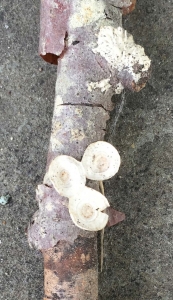
December 6, 2015 (Home studio)
Just getting back to the studio with a bunch of images I cut out on the drive to Michigan for Thanksgiving.
How nice. I got to paddle around Spectacle Pond with Steve Stycos to better see the pond, which feeds into Mashapaug Pond. Most of that pond is bordered by homes. There are no public parks, a few small access points where people fish. The access to the water’s edge is on a steep incline. Twin Oaks, Technics and the Garfield Avenue Plaza off Rt. 10 also occupy waterfront land on Spectacle Pond. Trash around the pond was evident but most noticeable behind the Stop and Shop bordering the pond. After getting the canoe back on the car we drove over to the Garfield Ave. Plaza and behind the Stop and Shop. Walking along a path by the water’s edge we picked up some trash and found dumpsters wide open. (Steve subsequently contacted Carlos Lopez Estrada, Chief of Staff for the Cranston Mayor’s office and the area was cleaned up within a couple days.)
I want to make a visual connection among the basic shapes of plankton and the other images. They all break down to basic visual elements found in children’s drawings. The beginnings of depicting the world around us are basic shapes – circle, lozenge shapes, triangles, mandalas, lines coming out of these basic shapes. They need just enough differentiation to be recognized as fish, birds, trees. I don’t want to be illustrative.

December 29, 2015 (Home studio)
Design finished. Obviously a lot of editing was involved in designing this piece. I was interested in combining a lot of different visual languages – delicate descriptive figures along with simplified graphic shapes that bordered on the cartoonish. Sources were children’s drawings from students at Reservoir Avenue School, Japanese 16th Century artist Sōtatsu, google images and invented ink drawings that grew from the varied marks of the round Japanese brush.
There were also so many images to choose from to depict the natural world from plankton to plants, fish, animals, insects, and birds. Though Lóren Spears said all the animals and plants are important there were certain ones I needed to be part of this – the deer, berries, turtle, cattails, frogs and ferns. At a few points I emailed the image to Loren for comment and shared it with a group of UPP supporters and received suggestions of figures I should include.
I enjoyed seeing the recurring structures from the growth of certain plants to the dragonfly, shapes of fish to that of birds, the frond of a fern to the branch structure of the pine tree. Within the plankton shapes the basis of the food chain their shapes are found – visual building blocks of other natural life.
I am continually amazed at the extreme articulateness of the silhouette; even the slightest change of a curve can differentiate the ear of a raccoon from that of a fox.
February – March, 2016:
The Steel Yard has fabricated the 16’ metal octagonal base and all the half circle fan structure along with all the figures. It was decided by Tim and I to move the middle arc closer to the outer arc of the piece giving more space for the figures in the fan sections. The figures are now arranged in each section and lines drawn for fabricators Holly and Isabel to shape the connecting undulating lines and weld the figures to the lines and the lines to the fan structure.
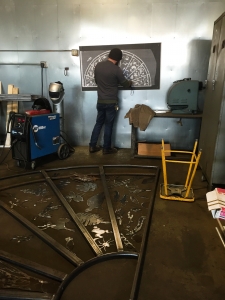
March 18, 2016:
Visited the Steel Yard to see how fabrication of the piece is coming. I was surprised to see all the figures cut out. Artists Holly and Isabel plasma cut all the figures making them very close to the originals. They were placed in the fan sections according to the design, but it all felt clunking and crowded. Tim and I discussed the translation from the paper design to metal and he had scaled it up 4 times the size of the original (2’ X 4’) to 8’ X16 ‘. In order to increase the fan sections and bring back some of the lace-like feel of the original Tim suggested bringing the middle arc out closer to the outer arc. That seemed a good solution. I will go next Tuesday to place all the figures and draw the connecting “journey” lines.
March 22, 2016:
Spent about 5 hours at the Steel Yard. The fan sections were larger, the, outer 2 arcs closer together and the whole thing felt more delicate. All the figures were neatly arranged in piles in each section, ready for me to put in place. Placing them was harder than I imagined as the design was backwards, with the front side facing the floor. At first I wasn’t sure all the pieces would fit but after some adjusting and rearranging they all felt like they were working together with some space to breath. I drew in the “journey” lines with chalk on the dark cement floor connecting the figures so they could be welded in at least two points. I managed to finish just before a UPP Art Board meeting at 6 pm. I hope that the lines are not too difficult for Holly and Isabel to replicate. Not an easy job!
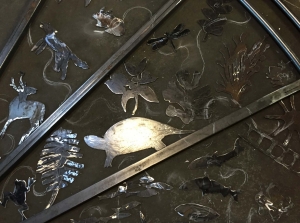
All photographs and design elements courtesy of Holly Ewald and UPP Arts
